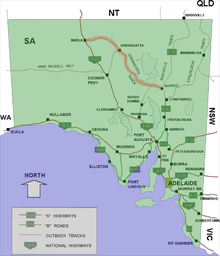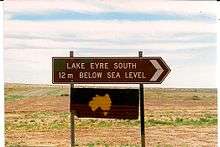Oodnadatta Track
The Oodnadatta Track is one of the easiest Outback tracks in Australia. This maintained gravel road follows the old Ghan railway line and the Overland Telegraph. The track is situated in central South Australia and runs from Marree to Marla, passing William Creek and Oodnadatta along the way. Many of the sights are connected with the old Ghan but there are also natural highlights, such as the so-called mound springs and Lake Eyre, the largest salt lake in Australia.
- This article is an itinerary.
Understand
With a total length of 617 kilometres, the Oodnadatta Track is not very long as Australian standards go -- and you don't really need a 4WD to get from Marree to Marla. But what it lacks in length and difficulty is largely made up for with historical and natural sights. You can have a look at the many sidings of the old Ghan railway, the ruins of a former rocket tracking installation site, the remains of a telegraph repeater station and the longest bridge in South Australia. The track also skirts Lake Eyre South, or if you're more adventurous you could drive to Lake Eyre proper from William Creek, one of the smallest settlements in Australia. And then there are the strange mound springs like The Bubbler or Blanches Cup -- yes, there is water in the driest part of Australia.
The track is essentially a diversion from the Stuart Highway from Port Augusta to Alice Springs. It largely follows the route of the old Ghan railway. The Ghan itself now largely follows the route of the Stuart Highway.
Prepare
As said before, this track is not as difficult as other outback tracks and can be driven in a conventional vehicle. Note that you do need a 4WD if you are going to tackle the road from William Creek to Lake Eyre. Fuel can be bought in Marree, William Creek, Oodnadatta and Marla, which are each about 200 kilometers apart, but try to avoid fueling up in William Creek as prices are steep. The main track is relatively well-traveled, so there's not much chance to be stranded for days, but some of the attractions are located a distance from the main track which may be less traveled. Reading the outback section of Driving in Australia is recommended, and will give you some advice on the do's and don'ts. You don't need special permits to travel this track.
This is remote country. People have died from exposure not far from the main track. Take adequate food and water. Consider hiring a satellite phone and taking an additional spare tyre.
Check the road conditions with the Government of South Australia , or contact the Pink Roadhouse in Oodnadatta. Check the conditions before you start on the track, and again before you set out each day. The road conditions can change rapidly and the track can be closed to 2WD or 4WD traffic at any time of year. If rain is forecast, and you are in a two wheel drive, consider just staying put for a few days rather than have the unpleasant experience of battling the track in the wet.
Arrive/Leave
Drive
Marree to William Creek

The southeastern end of the track starts in Marree, an uninspiring outback town. Still, it is -- or rather, was -- more important than you might think. This was the staging post for the Afghan camel trains that supplied the South Australian and Northern Territory outback, before they were replaced by the Ghan railway. (As you may have suspected, the name of the railway actually is a corruption of those Afghan camel trains.) Marree also lies at the junction of the Oodnadatta and the Birdsville tracks.
Driving the Oodnadatta is quite straightforward: you start at the junction with the Birdsville track, and with very few exceptions it's straight on to Marla. In the first 70 or so kilometers you pass a few railway sidings (Callanna after 15km, Wangianna after 36km, Alberrie after 53km and Bopeechee after 69km). Between Wangianna and Alberrie, 43km from Marree, you pass the dog-proof fence, one of the longest human-made barriers in the world. Running for 5,400 km. from the South Australian to the Queensland coast, it is meant to protect the sheep in southeastern Australia from dingo attacks.
85 km. from Marree you can take a short side trip (3km return) to have a look at Lake Eyre South, 12 m. below sea level. This is not the main body of the lake, but a natural extension connected to Lake Eyre proper by the Goyder Channel. Chances are that you won't see much else than a large expanse of salt, as the lake rarely contains water. Do not attempt to drive on the lake -- you won't be the first one to have your vehicle immobilised when the salt crust breaks and you're stuck in the slimy goo underneath. Getting you out might prove very difficult, as other vehicles won't risk driving to where you got stuck.
One of the more interesting sidings along the track is Curdimurka, 102 km. from Marree. It gives a good impression of how the settlers who looked after the railway line lived. While other sidings have fallen into disrepair, this one is preserved by the Ghan Railway Preservation Society. To finance their effort, an outback ball is held here every two years.

126 km. from Marree you can make a worthwhile diversion to the left of the main track to see the two best known mound springs in this area: The Bubbler and Blanches Cup. Mound springs are places where the underground water of the Great Artesian Basin (the world's largest aquifer) reaches the earth's surface. The mound is formed by the dissolved salts left by the evaporated water. It is quite an odd thing to realize that you are in the driest part of the driest state of the driest continent in the world, and yet you are walking on an enormous "underground sea!" If you continue on this side track you will rejoin the Oodnadatta track about six km. from where you left it.
Just a little further on you arrive at Coward Springs, a camp site where you can relax at the spa, explore the historical rail siding, take a self guided walk or even go on a camel safari.
Between here and William Creek there are a few other minor sights, such as the Beresford Bore siding (156km from Marree), a historic rocket tracking emplacement (at the end of a one km. road, 200 m. further on), Strangeways Bore and Irrapatana sidings (respectively 169 km and 186 km from Marree). Seven km. before you arrive at William Creek (and 199 km from Marree) a track to the right leads to Lake Eyre, but don't take this before having advised the people at William Creek of your plans.
Lake Eyre side-trip

If you have a 4WD it is possible to make a 160 km. return trip to the shores of Lake Eyre. Drive seven km. back in the direction of Marree and take the Anna Creek Station track on your left. This track is quite rough and the nearer you come to Lake Eyre, the sandier it gets. In the last stretch you drive through a dark moonlike landscape where nothing grows anymore.
Arriving at Lake Eyre is like arriving at a place where some ghastly disaster happened. The whole area seems void of life and the sun beats merciless on the completely barren landscape. Because of the flat terrain the wind blows undisturbed. You will probably need protective clothing like long trousers, a sweater and a hat to shield yourself from flying sand and salt. Sunglasses will do the same for your eyes and you will avoid getting snowblind (the salt has the same effect as snow). Nevertheless, in spite of -- or maybe because of -- these almost unearthly conditions, it is really an experience.
Some more words of warning: do not drive on the salt crust. As said before, you risk losing your vehicle. And out here, exposed to extreme natural conditions, a human being will not survive for very long without protection. Before tackling this trip you also should inform the people at William Creek*. Tell them how many people and how many vehicles are in your party and for how long you will be away. If need be they will start a search. Remember that this is a dead-end track and weeks can pass before another vehicle comes by. People have died out here because they ran into car trouble and nobody was informed of their whereabouts.
- Note: William Creek will not accept details of travel anymore, due to possible legal actions.
William Creek to Oodnadatta